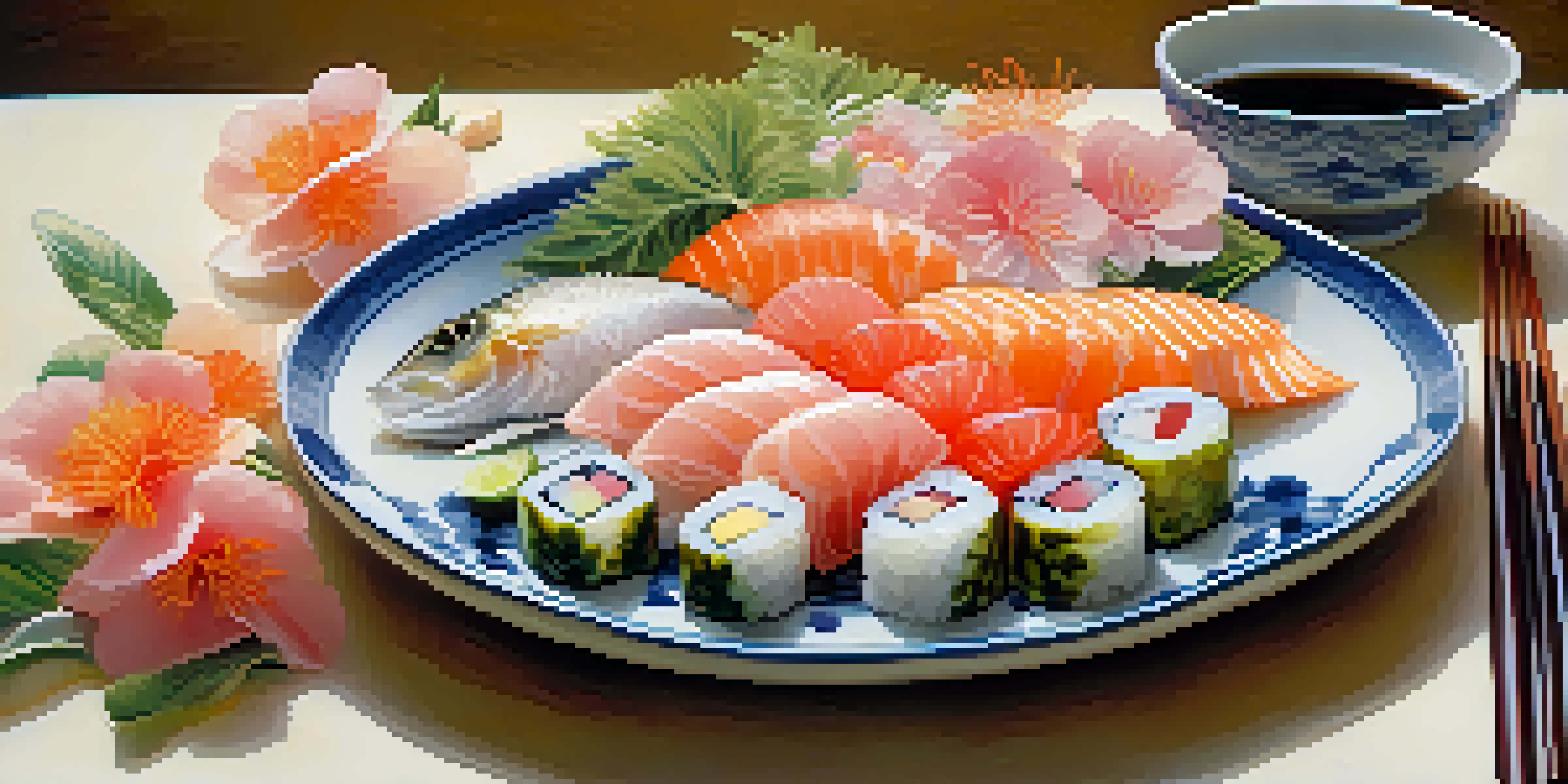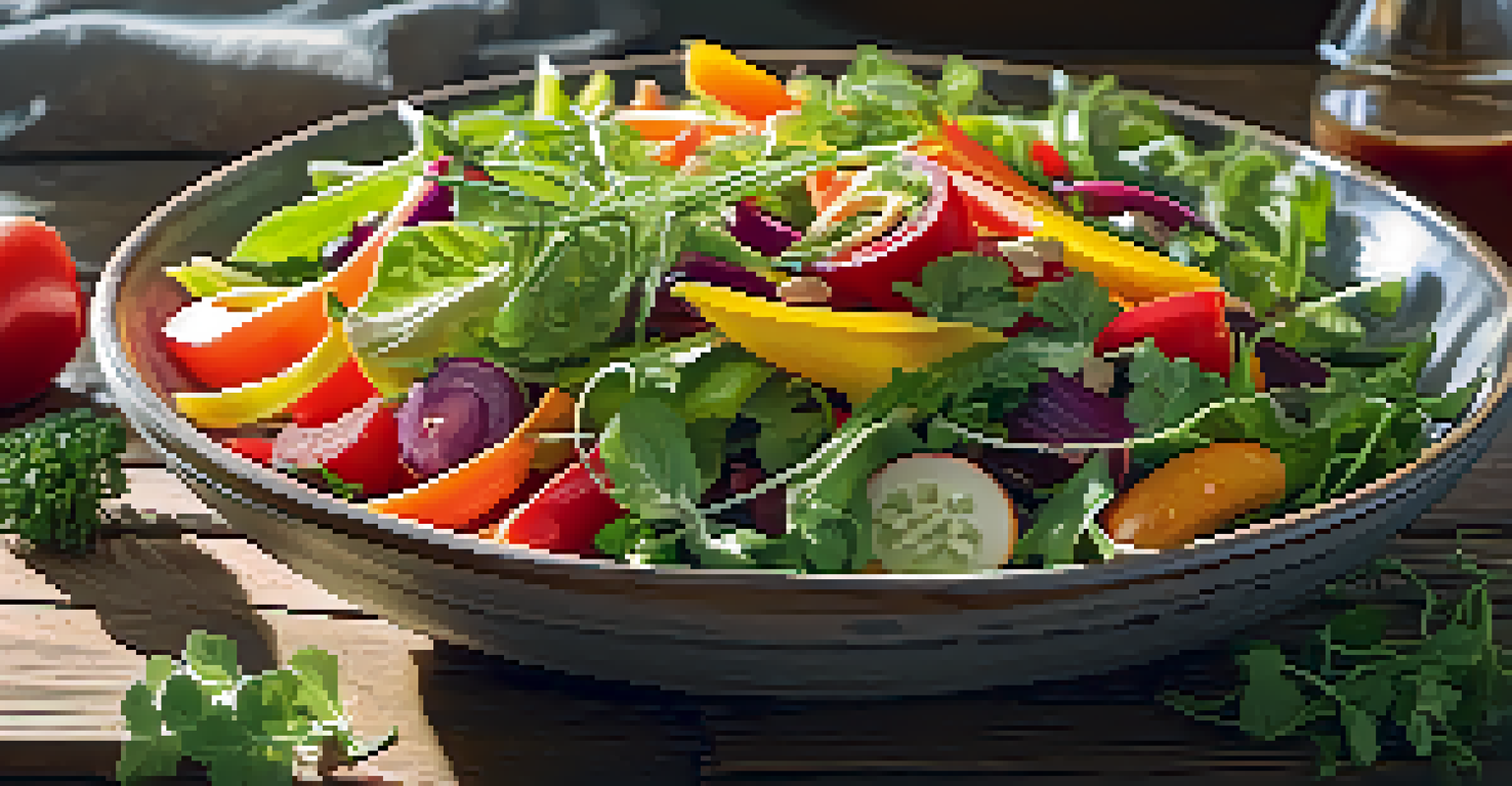Culinary Traditions: Raw Food Practices in Japan and Beyond

Understanding Raw Food Practices in Japan
Raw food practices in Japan are deeply rooted in the culture, emphasizing freshness and seasonality. Traditional dishes like sashimi showcase the natural flavors of pristine seafood, prepared simply to highlight its quality. This approach not only preserves nutrients but also respects the ingredients, reflecting a philosophy of harmony with nature.
Food is our common ground, a universal experience.
In Japan, the art of preparing raw food is a skill passed down through generations. Chefs undergo rigorous training to master techniques that enhance the taste and texture of raw ingredients. For instance, the careful slicing of fish for sashimi requires precision and an understanding of the fish's anatomy, making it a true craftsmanship.
Moreover, raw food practices extend beyond sushi and sashimi to include various vegetables and fermented foods. Dishes like 'namul' (seasoned vegetables) showcase how raw ingredients can be flavorful and nutritious, illustrating the versatility of this culinary approach. This tradition encourages a diet rich in fresh, unprocessed foods.
The Nutritional Benefits of Raw Foods
Raw foods are often celebrated for their nutritional value, as cooking can sometimes diminish key vitamins and minerals. Foods like fruits, vegetables, and nuts retain their natural enzymes and nutrients when consumed raw, contributing to overall health. This is particularly beneficial for individuals seeking a diet high in antioxidants and fiber.

Incorporating raw foods into your diet can also aid in digestion and promote a feeling of fullness without excessive calorie intake. For instance, a raw salad packed with leafy greens and colorful veggies can be both satisfying and low in calories, making it an excellent choice for those looking to manage their weight. Plus, the variety of textures and flavors can make meals exciting.
Cultural Roots of Raw Food
Raw food practices in Japan emphasize freshness and seasonality, showcasing a deep respect for ingredients and nature.
However, it's important to balance raw foods with cooked options, as some ingredients, like tomatoes, release more nutrients when cooked. The key is to enjoy the best of both worlds, ensuring a diverse and healthful diet that caters to your taste preferences and nutritional needs.
Raw Food Trends Beyond Japan
While Japan is renowned for its raw food practices, many cultures around the world embrace similar philosophies. For example, in the Mediterranean, dishes like carpaccio and tartare celebrate the simplicity of raw meats and fish. These dishes, rich in flavor and tradition, highlight how various cultures value fresh, high-quality ingredients.
Let food be thy medicine and medicine be thy food.
In recent years, the global raw food movement has gained traction, with many people adopting raw vegan diets. This lifestyle emphasizes whole, unprocessed foods, often featuring creative recipes that blend fruits, vegetables, nuts, and seeds. Restaurants and cafes specializing in raw cuisine have emerged, showcasing innovative dishes that appeal to health-conscious eaters.
Moreover, raw food practices often intersect with sustainable eating trends, as many raw food enthusiasts prioritize local, organic ingredients. This not only supports local farmers but also reduces the carbon footprint associated with food transport. By choosing raw foods, individuals can align their eating habits with a more environmentally friendly lifestyle.
Cultural Significance of Raw Foods
Raw food practices hold cultural significance in many societies, often tied to rituals and traditions. In Japan, for example, the presentation of sashimi is an art form, reflecting a deep respect for the ocean and its bounty. Each dish tells a story, connecting diners to the land and sea, creating a shared experience at the table.
Similarly, in cultures around the world, raw foods are often integral to celebrations and communal gatherings. Whether it's a fresh seafood platter at a summer BBQ or a vibrant raw vegetable spread at a family gathering, these dishes foster connection and joy. They serve as a reminder of the importance of community and shared meals in human experience.
Nutritional Advantages of Raw Foods
Incorporating raw foods into your diet can enhance nutrient intake and promote digestive health.
Additionally, the preparation of raw foods can be seen as a meditative practice. The process of selecting fresh ingredients, slicing, and arranging them beautifully can bring a sense of mindfulness and appreciation for food. This thoughtful approach to cooking encourages individuals to slow down and savor the moment, enhancing the overall dining experience.
Popular Raw Dishes to Try
If you're curious about exploring raw food practices, there are plenty of delicious dishes to start with. In addition to classic sashimi, consider trying 'narezushi,' a fermented sushi made with raw fish and rice. This ancient dish showcases the diversity of raw preparations in Japanese cuisine and offers a unique taste experience.
Outside Japan, you might enjoy a refreshing ceviche, where raw fish is marinated in citrus juice, creating a bright and zesty dish. Many Latin American countries have their own versions, each with unique ingredients that reflect local flavors. This dish illustrates how raw foods can be both simple and complex, depending on the preparation.
For a plant-based option, consider a colorful raw vegetable salad tossed with a zesty dressing or a vibrant smoothie packed with fresh fruits. These dishes are not only nutrient-dense but also visually appealing, making them a joy to eat. The beauty of raw food is that there's always something new to discover and enjoy.
Raw Food and Sustainability
Sustainability plays a significant role in the raw food movement, as many advocates prioritize local and organic ingredients. By choosing seasonal produce and supporting local farmers, raw food enthusiasts help reduce the environmental impact associated with food production and transportation. This conscious choice promotes a healthier planet.
Furthermore, the raw food lifestyle often encourages reducing waste by utilizing the whole ingredient. For instance, vegetable scraps can be used to make stocks or compost, showcasing a commitment to sustainability. This approach not only minimizes waste but also fosters creativity in the kitchen.
Sustainability in Raw Food Choices
Choosing local and organic raw ingredients supports sustainability while providing health benefits.
Moreover, the focus on plant-based raw foods aligns well with environmental sustainability goals, as plant-based diets tend to have a smaller carbon footprint compared to meat-heavy diets. By incorporating more raw plant foods into your meals, you can contribute to a more sustainable future while enjoying delicious and nutritious dishes.
Embracing Raw Food Practices in Everyday Life
Integrating raw food practices into your daily routine can be both fun and rewarding. Start by incorporating more raw fruits and vegetables into your meals, such as snacking on fresh carrots or adding avocado slices to your salads. This simple adjustment can enhance your diet while introducing new flavors and textures.
You might also explore raw food recipes at home, experimenting with smoothies, salads, and even raw desserts. There are countless resources available, from cookbooks to online blogs, offering inspiration and guidance. Trying out new recipes can be a great way to engage with the raw food philosophy and discover what you enjoy most.

Lastly, consider visiting local farmers' markets to connect with fresh, seasonal produce. This not only supports local agriculture but also allows you to choose the best quality ingredients for your meals. By embracing raw food practices, you can cultivate a healthier lifestyle while enjoying the vibrant flavors nature has to offer.